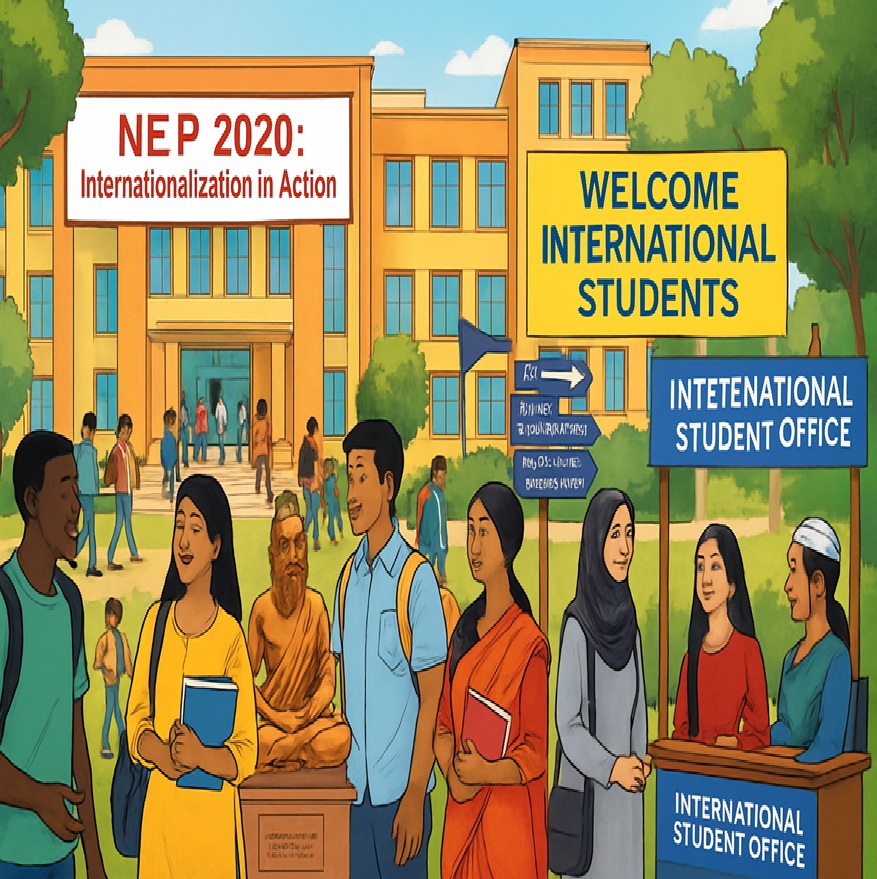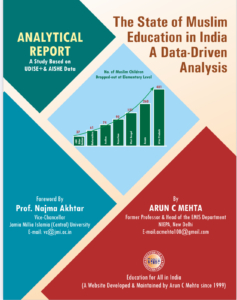Internationalization of Indian Higher Education: Progress, Challenges, and Pathways to Achieve NEP 2020 Objectives
Internationalization of Indian Higher Education: Progress, Challenges, and Pathways to Achieve NEP 2020 Objectives
Abstract
The National Education Policy (NEP) 2020 envisions India as a global education hub by promoting internationalization through attracting foreign students, establishing foreign university campuses, fostering international collaborations, and enabling credit transfer mechanisms. This article critically evaluates the progress of these objectives, drawing on Unified District Information System for Education (UDISE+) data, policy documents, and scholarly analyses. It examines structural, financial, and regulatory barriers, proposes strategies to achieve NEP 2020’s goals, and assesses the potential role of the proposed Higher Education Commission of India (HECI). The analysis highlights the need for robust infrastructure, streamlined regulations, and inclusive policies to align India’s higher education with global standards by 2030.
Internationalization & Globalization on Higher Education 2023
Economic Influence of International Students on India’s Higher Education System
1. Introduction
Internationalization of higher education is a global imperative, enhancing academic quality, cultural exchange, and economic competitiveness (Knight, 2004; de Wit, 2019). India’s National Education Policy (NEP) 2020 articulates a transformative vision to position the country as a “global study destination” by attracting 500,000 international students by 2024, facilitating foreign university campuses, and promoting academic mobility through collaborations and credit transfers (GoI, 2020). These objectives align with NEP 2020’s broader goal of achieving universal school and higher education by 2030, as emphasized in analyses of UDISE+ data (Mehta, 2024a). However, India’s higher education system faces challenges, including low gross enrolment ratios (GER), infrastructural deficits, and regulatory complexities (Mehta, 2023). This article assesses the progress of NEP 2020’s internationalization agenda, integrates UDISE+ data to contextualize higher education trends, and evaluates the role of the proposed Higher Education Commission of India (HECI) in achieving these goals. It draws on resources from Education for All in India to ensure alignment with data-driven educational discourse.
2. NEP 2020’s Internationalization Objectives
NEP 2020 outlines a strategic framework for internationalizing Indian higher education, emphasizing four key pillars:
- Attracting Foreign Students: The “Study in India” program aims to enroll 500,000 international students by 2024, leveraging affordable education and cultural diversity (GoI, 2020).
- Foreign University Campuses: The policy permits top-ranked foreign universities to establish campuses in India, reducing outbound student mobility and fostering competition (GoI, 2023a).
- International Collaborations: NEP 2020 encourages joint degrees, research partnerships, and faculty/student exchanges to enhance global exposure (Mehta, 2024b).
- Credit Transfer Mechanisms: The National Credit Framework (NCrF) facilitates academic mobility by aligning Indian qualifications with global standards (GoI, 2022).
These objectives support NEP 2020’s vision of universal higher education, with a target GER of 50% by 2035 (GoI, 2020). However, as Mehta (2024a) notes, achieving universal education requires addressing inefficiencies at primary and secondary levels, which impact higher education enrollment.
3. Progress of Internationalization Efforts
3.1 Attracting Foreign Students
India’s inbound student mobility remains modest, with approximately 49,348 international students enrolled in 2022–23, primarily from South Asia and Africa (GoI, 2023b). The “Study in India” program has facilitated 1,283 scholars from 56 countries between 2015 and 2019 through scholarships like the Indian Council for Cultural Relations (ICCR) scheme (Varghese & Mathews, 2021). However, the 500,000-student target by 2024 has not been met, with projections suggesting only 60,000 students by 2025 (EduMinOfIndia, 2025). Challenges include limited global visibility, quality concerns, and infrastructural gaps, as highlighted in Mehta’s (2023) analysis of UDISE+ data, which underscores persistent dropout rates at secondary levels (Table 1) that limit progression to higher education.
3.2 Foreign University Campuses
The University Grants Commission (UGC) regulations of 2023 have enabled foreign higher educational institutions (FHEIs) to establish campuses in India (GoI, 2023a). Key developments include:
- Deakin University and the University of Wollongong opening campuses at GIFT City, Gujarat (EduMinOfIndia, 2025).
- The University of Southampton receiving a Letter of Intent (LoI) for a campus in Gurugram (UGC_India, 2025).
- Three additional Australian universities securing UGC approval by July 2025 (UGC_India, 2025).
These campuses aim to retain the $15 billion spent annually by outbound Indian students (Aithal & Aithal, 2020). However, only 10 LoIs have been issued in the past three months, indicating slow progress (EduMinOfIndia, 2025).
3.3 International Collaborations
International partnerships have expanded, with over 700 Indian higher education institutions (HEIs) establishing International Affairs offices (GoI, 2021). Programs like the Scheme for Promotion of Academic and Research Collaboration (SPARC) and Global Initiative of Academic Networks (GIAN) have facilitated joint degrees and research alliances, particularly in STEM fields (Mehta, 2024b). A 2025 survey of 117 HEIs found that 40% had 1-5 years of collaboration experience, led by professors (50%) and administrators (35%) (ResearchGate, 2025). However, collaborations remain skewed toward sciences, limiting interdisciplinary engagement (Varghese, 2020a).
3.4 Credit Transfer Mechanisms
The UGC’s 2022 regulations on twinning, joint, and dual degree programs enable credit mobility (GoI, 2022). Over 100 HEIs have implemented credit transfer agreements, particularly in data analytics and computer science (GoI, 2022). The NCrF aligns Indian credits with global frameworks, but inconsistent adoption and quality assurance challenges persist (Mehta 2024).
4. UDISE+ Data: Contextualizing Higher Education Trends
UDISE+ data provides critical insights into India’s education system, highlighting trends that impact higher education internationalization (Mehta, 2024a). Table 1 summarizes key indicators from 2020–21 to 2023–24.
| Indicator | 2020–21 | 2021–22 | 2022–23 | 2023–24 |
|---|---|---|---|---|
| GER (Primary, %) | 103.3 | 103.4 | 96.2 | 93.0 |
| GER (Upper Primary, %) | 92.2 | 94.7 | 90.2 | 89.7 |
| GER (Secondary, %) | 79.8 | 79.6 | 79.2 | 77.4 |
| GER (Higher Secondary, %) | 53.8 | 57.6 | 56.8 | 56.2 |
| Dropout Rate (Secondary, %) | 14.6 | 12.6 | 16.4 | 14.1 |
| Number of Schools (All Levels) | 1,509,136 | 1,489,115 | 1,466,109 | 1,471,891 |
| Primary Enrolment (Million) | 122.0 | 121.8 | 112.4 | 107.8 |
Source: UDISE+ 2023–24, adapted from Mehta (2024a), School Education in India: Where Do We Stand?
The data reveals steady GER growth across levels, with primary education nearing universalization (93% in 2023–24). However, secondary (77.4%) and higher secondary (56.2%) GERs remain below NEP 2020’s targets, reflecting inefficiencies that constrain higher education enrollment (Mehta, 2023). Secondary dropout rates, though declining (14.1% in 2023–24), indicate retention challenges, particularly for marginalized groups, as noted in Mehta’s (2024c) analysis of Muslim education. These trends underscore the need for a robust feeder system to support higher education internationalization.
The chart shows consistent GER growth, but the higher secondary GER (56.2% in 2023–24) remains below the 50% higher education GER target, indicating a bottleneck in the education pipeline (Mehta, 2023).
5. Challenges to Internationalization
NEP 2020’s internationalization objectives face significant barriers:
- Infrastructural Deficits: Many HEIs lack world-class facilities, deterring foreign students and institutions (Sen, 2015). Mehta (2024a) highlights declining school numbers (1,471,891 in 2023–24), reflecting resource constraints that extend to higher education.
- Regulatory Complexities: Bureaucratic delays in visa processing and campus approvals hinder progress (Wadhwa, 2019). The shelving of earlier internationalization initiatives, like PIHEAD 2002, underscores persistent administrative challenges (Varghese & Mathews, 2021).
- Quality Gaps: Skill mismatches and outdated curricula limit global competitiveness, with only 28% of educators believing graduates are job-ready (Deloitte, cited in Alliance.edu.in, 2021).
- Financial Constraints: Limited public funding and reliance on foreign direct investment (FDI) risk inequitable access, particularly for marginalized groups (Aithal & Aithal, 2020).
- Imbalanced Mobility: Outbound student mobility (1.3 million in 2022) far exceeds inbound flows, reflecting India’s struggle to compete with Anglophone hubs (InvestIndia, 2023).
These challenges are compounded by inefficiencies at lower education levels, as Mehta (2024a) notes, with secondary dropout rates (14.1% in 2023–24) limiting higher education access.
6. Linking Internationalization to NEP 2020’s Broader Goals
NEP 2020’s internationalization agenda is integral to its vision of universal education by 2030, encompassing school and higher education (GoI, 2020). The policy’s emphasis on foundational learning and retention at primary/secondary levels (Mehta, 2024a) is critical for creating a robust pipeline for higher education. However, UDISE+ data indicates that universal school education by 2030 is challenging, with secondary GER (77.4%) and dropout rates (14.1%) signalling inefficiencies (Mehta, 2023). Internationalization efforts must therefore be supported by:
- Strengthening school education to boost higher education GER.
- Aligning curricula with global standards to enhance employability.
- Promoting equity to ensure marginalized groups access internationalized HEIs (Mehta, 2024c).
7. Role of the Higher Education Commission of India (HECI)
The proposed HECI, envisioned under NEP 2020, aims to replace the UGC with a single regulator for higher education, streamlining governance, accreditation, and funding (GoI, 2020). The HECI could advance internationalization by:
- Simplifying Regulations: Centralizing approvals for foreign campuses and credit transfers, reducing bureaucratic delays (Varghese, 2020a).
- Enhancing Quality Assurance: Establishing rigorous accreditation frameworks to align HEIs with global standards, boosting credibility (Mehta, 2024b).
- Promoting Equity: Allocating funds to public HEIs and subsidies for marginalized students at foreign campuses (Alliance.edu.in, 2021).
- Fostering Collaborations: Incentivizing interdisciplinary partnerships through grants and policy support (Gangrade, 2022).
However, the HECI’s effectiveness depends on its autonomy, transparency, and capacity to address infrastructural and financial constraints (Deb, 2020). Without these, it risks replicating existing regulatory inefficiencies.
8. Strategies to Achieve NEP 2020’s Internationalization Objectives
To realize NEP 2020’s internationalization goals by 2030, the following strategies are proposed:
- Invest in Infrastructure: Increase public and private funding for HEI facilities, prioritizing rural and public institutions to attract foreign students and faculty (Sen, 2015).
- Streamline Regulations: Adopt Australia’s streamlined visa framework to simplify processes for international students and FHEIs (Brunner, 2023).
- Diversify Collaborations: Expand partnerships in arts, humanities, and social sciences to foster holistic internationalization (Varghese, 2020a).
- Standardize Credit Transfers: Implement NCF uniformly across HEIs, supported by HECI-led quality assurance (Mehta, 2024b).
- Enhance Global Visibility: Market India’s cultural and academic strengths through targeted campaigns, leveraging platforms like Education for All in India (Mehta, 2024a).
- Ensure Equity: Subsidize fees at foreign campuses and prioritize scholarships for marginalized groups, as advocated in Mehta’s (2024c) analysis of Muslim education.
- Strengthen School Education: Reduce secondary dropout rates and boost GERs to create a robust higher education pipeline (Mehta, 2023).
9. Concluding Observations
NEP 2020’s internationalization agenda offers a transformative vision for Indian higher education, but progress remains uneven. While foreign campuses and collaborations show promise, the 500,000-student target is unmet, and challenges like infrastructural deficits, regulatory hurdles, and quality gaps persist. UDISE+ data underscores the need for a robust school education system to support higher education access, with secondary dropout rates and GERs highlighting inefficiencies (Mehta, 2024a). The proposed HECI could streamline governance and enhance quality, but its success hinges on autonomy and resource allocation. By investing in infrastructure, standardizing credit transfers, and ensuring equity, India can align with NEP 2020’s global aspirations by 2030. Future research should explore the long-term impact of foreign campuses and the HECI’s role in fostering inclusive internationalization.
Suggested Readings
Aithal, P. S., & Aithal, S. (2020). Analysis of the Indian National Education Policy 2020 towards achieving its objectives. International Journal of Management, Technology, and Social Sciences, 5(2), 19–41.
Alliance.edu.in. (2021). Impact of NEP 2020 on Indian higher education. Alliance University.
Brunner, L. R. (2023). International education and migration nexus: The ‘edugration’ trend. Higher Education Research & Development, 42(5), 1234–1248.
Deb, S. (2020). Internationalization of higher education in India: Opportunities and challenges. Higher Education Quarterly, 74(3), 245–260.
de Wit, H. (2019). Internationalization in higher education: A critical review. Journal of International Students, 9(3), 835–849.
EduMinOfIndia. (2025). India emerging as a transnational education hub. X Post.
Gangrade, P. (2022). NEP 2020: A catalyst for global partnerships in Indian higher education. Journal of Indian Education, 48(2), 34–50.
GoI. (2020). National Education Policy 2020. Ministry of Education, Government of India.
GoI. (2021). Guidelines for internationalization of higher education. University Grants Commission.
GoI. (2022). UGC (Academic Collaboration between Indian and Foreign HEIs) Regulations, 2022. The Gazette of India.
GoI. (2023a). UGC (Setting up and Operation of Campuses of FHEIs in India) Regulations, 2023. The Gazette of India.
GoI. (2023b). All India Survey on Higher Education (AISHE) 2022–23. Ministry of Education.
InvestIndia. (2023). Internationalisation of higher education in India. Invest India.
Knight, J. (2004). Internationalization remodelled: Definition, approaches, and rationales. Journal of Studies in International Education, 8(1), 5–31.
Mehta, A. C. (2023). School Education in India: Where Do We Stand? Analysis based on UDISEPlus 2023-24. Education for All in India.
Mehta, A. C. (2024a). Analysis of UDISEPlus 2021-22, 2022-23 and 2023-24. Education for All in India.
Mehta, A. C. (2024b). Computing Un-computed Indicators NEP2020. Education for All in India.
Mehta, A. C. (2024c). The State of Muslim Education in India: A Data-Driven Analysis. Education for All in India.
Mehta, A. C. (2024d). AI-Driven Educational Data Management in India: Optimizing SDMS & UDISEPlus. Education for All in India.
ResearchGate. (2025). Role of NEP 2020 in encouraging global partnerships in Indian higher education. ResearchGate.
Sen, D. (2015). Challenges in Indian higher education: A policy perspective. Economic and Political Weekly, 50(38), 65–72.
UGC_India. (2025). Foreign universities receive LoIs for Indian campuses. X Posts.
Varghese, N. V. (2020a). Internationalization of higher education in India: Trends and perspectives. Higher Education for the Future, 7(1), 1–15.
Varghese, N. V., & Mathews, E. (2021). Internationalization and India’s new education policy. ResearchGate.
Wadhwa, R. (2019). India’s higher education: Challenges and opportunities for internationalization. Journal of Higher Education Policy and Management, 41(4), 432–448.



